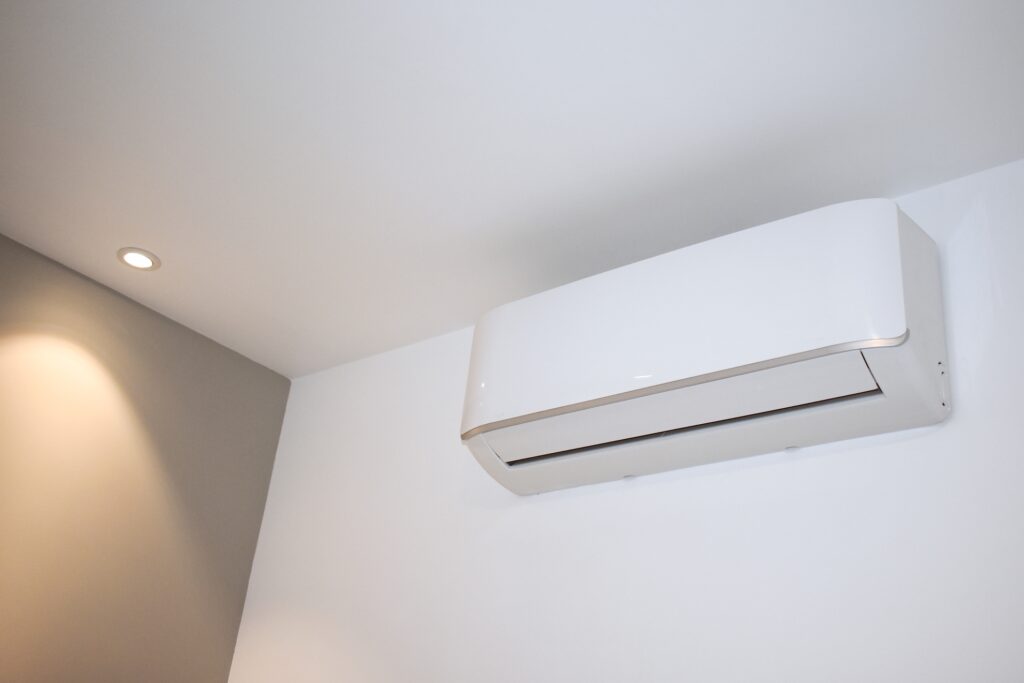
Thinking about installing a ductless AC? Before you do, it’s important to understand how these innovative systems work.
Despite the name, a ductless air conditioner is not actually an air conditioner — it’s so much more than that. The term ductless air conditioner is a misnomer for ductless heat pump, which is a highly efficient HVAC system that can both heat and cool your home without the need for ductwork.
To explain how a ductless AC (aka a ductless heat pump) works, we need to look at two key aspects: how it provides heating and cooling, and how it operates without ducts.
Let’s dive in.
Key Components of a Ductless Heat Pump System
Before we get into how it works, let’s look at the main components of a ductless heating and cooling system.
- Outdoor Unit – The outdoor unit houses the compressor, condenser coil, and a fan. It’s the powerhouse of the system, driving the refrigerant cycle that facilitates both heating and cooling.
- Indoor Air Handlers – The indoor air handlers (also called heads) are the units mounted inside your home, usually on walls or ceilings. They deliver heated or cooled air directly into the rooms they’re installed in.
- Refrigerant Lines – The refrigerant line connects the indoor and outdoor units and carries refrigerant between them. It’s installed by drilling a small hole in an exterior wall that the line can run through.
- Control System – Each indoor air handler can be controlled separately via a remote control or thermostat. This allows you to set different rooms or areas in your home to different temperatures.
How Does a Ductless AC Heat and Cool?
A ductless AC, or more accurately, a ductless heat pump, uses refrigerant to transfer heat into and out of your home. In cooling mode, it transfers heat from the air indoors to the air outside. In heating mode, it works in reverse by absorbing heat from the air outside and bringing it in. Here’s a more detailed look at how this process works.
Cooling Mode
When set to cooling mode, the liquid refrigerant inside an airtight coil absorbs heat from the indoor air and evaporates into a gas. As the refrigerant evaporates, it cools – as does the surrounding air which is then circulated back into the room by the indoor unit’s fan. The refrigerant gas, now carrying the absorbed heat, travels through the refrigerant line to the outdoor unit. Here, the compressor compresses the gas, raising its temperature and pressure. The hot, high-pressure refrigerant gas flows through the condenser coil in the outdoor unit. The outdoor fan blows air over the coil, releasing the heat from the refrigerant to the outside air.
Heating Mode
In heating mode, the process is essentially reversed, thanks to a reversing valve, which changes the direction of the refrigerant flow. The outdoor unit absorbs heat from the outside air. Even in cold weather, there is still some heat present. The refrigerant absorbs this heat and evaporates into a gas. The refrigerant gas is then compressed by the compressor in the outdoor unit, increasing its temperature and pressure. The hot refrigerant gas moves to the indoor unit, where it releases its heat as it condenses back into a liquid. This heat is transferred to the indoor air, warming your home.
How Can a Heat Pump Work without Ductwork?
A ductless heat pump operates without ducts by using individual indoor air handlers to distribute heated and cooled air directly into the room they’re installed in. The air handlers are connected to the outdoor unit via refrigerant lines, which carry the refrigerant back and forth to facilitate the heat exchange process. Because the air handlers are installed in the spaces they serve, there’s no need for ductwork to transport air throughout the home. This direct delivery system reduces energy losses associated with duct leaks and improves overall energy efficiency. Each air handler can be independently controlled, allowing for customized comfort in different areas of the home, further enhancing the system’s efficiency.
Ductless Heat Pump Installation in Massachusetts
Want to install a ductless heating and cooling system in your home? Contact Neeeco today! We can help you install a new ductless system and qualify for Massachusetts heat pump rebates in 2024. You may also be eligible for the federal heat pump tax credit, which can save you up to $2,000 on heat pump installation.
